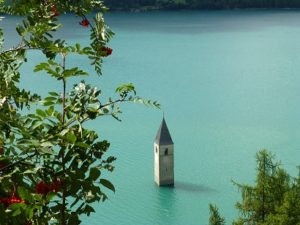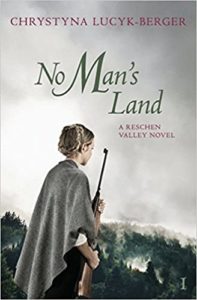Many years ago, while we were living in Italy, I visited the Alto Adige, or the Südtirol as it is known in German. We returned on various occasions, winter and summer, and I fell in love with the scenery: the only word for it is ‘dramatic’. But so is the history half-hidden among the ancient alpine passes and modern ski resorts; the difficult past that must have been so hard to bear for people who felt themselves to be Austrian or Tyrolean – not Italian. For this reason, I was drawn to Chrystyna Lucyk-Berger’s award-winning Reschen Valley series.

If you have not come across this writer before, Lucyk-Berger is an American ex-pat living in western Austria. Her natural storytelling skills, and her innate curiosity about how the past shapes our present have formed her into a successful historical fiction writer.
Here is some historical background and a very brief summary of the storyline for the series.
After the Great War, a new conflict in Europe began. When Austria’s Tyrolean province was split in two, the southern half was annexed by Italy. In The Reschen Valley Series, two families cross paths: the Thalers, a Tyrolean farming family, and the Grimanis, an Italian industrial family racing to develop Italy’s new frontiers before a second war breaks out. When the Fascists reveal plans to flood a valley that would drown out the Thalers’ family, both sides must weave their way through a labyrinth of corruption, prejudice and greed.
Q: I asked Chrystyna why she was drawn to write about the Reschen Valley? What was it about the location that caught her interest or imagination?
A: The Reschen Valley is actually called Oberer Vinschgau/Reschia. Imagine driving south over an alpine pass, crossing from Austria into Italy. You might expect Italian restaurants, Italian signs, and Italian architecture, but that’s not what happens. It still looks like the Austrian Tyrol with a few Italian names and the German language is very present.
Keep driving, because here it comes: spread out before you, a beautiful aquamarine-blue reservoir nestled between the Alpine peaks and spreading some four miles into the southern horizon. It takes your breath away. You pass the first town and quickly come upon the next one called Graun / Curon Venosta. And then there it is. Off to the right, some 50 feet from the lakeshore, is a fully intact medieval church tower rising straight out of the water. The valley beneath the lake is the setting of my Reschen Valley series.

It took me almost five years and a lot of German improvement to figure out what the heck happened. The deeper into the history I went, the more mysterious and thrilling the story became, especially in regard to how the reservoir was built.
I was making two or three trips a year there, spending a lot of time in the province and getting to know two cultures: the Austrian Tyrolean one and the northern Italian one. By the time I visited the Reschen Lake reservoir for the tenth time, a whole slew of characters had risen above its surface: a young farmer woman, a sassy innkeeper, an Italian engineer, a German carpenter, a dog. A Fascist colonel. They clambered into my Nissan Micra and never let go.
The real history reads like a thriller. There was an awful lot of planning, and this was years before the European conflict broke out. The risorgimento was a nationalist movement and their belief was that Italy’s borders had been pre-destined by Dante. The nationalists were delighted when England, France and Russia came with a proposal in 1915, the secret Treaty of London, proposing: “Please help us to win the war.”
“Sure,” the Italian nationalists said, “and when we win, we get these territories, especially that Brenner Pass line.”
After WWI, U.S. President Woodrow Wilson was completely perplexed by the Italy’s claim to territories inhabited by Slav and German-speaking citizens. It was fully against his proposed 14 points! But that’s another long and tragic story.
Q: You have four of six books completed for the series, and a couple of WW2 novels, too, when will the last two books be finished, and what’s next?
The next book in the series, Two Fatherlands is a monster of a novel but it will be published — come hell or high water — end of October or possibly delaying it to early November to mark the 100 years since South Tyrol’s annexation to Italy. Either way, I will decide in July when I’ve delivered the manuscript. I had to send the book into the corner last November and give it a break. It helped a lot. I’m back on it and in between, I wrote what I thought was just going to be a reader’s magnet, and has turned into a celebrated collection. Souvenirs from Kiev is based on my relatives’ histories during WWII in Ukraine and takes readers on a perilous journey from the Underground to the DP camps of Germany. That release has opened new doors for me!
Also while struggling with Two Fatherlands last fall, I had agreed to join a project with five other authors to put together a collection of novels for the 75th anniversary of the end of WW2. Magda’s Mark appears in the The Road to Liberation collection this May. It is based on a true story about my friend’s husband. Her father-in-law was a district SS officer in Moravia (Czechsolovakia/Sudetenland). When his son was born, the baby was returned to the mother circumcised. Now, can you imagine the repercussions?

As soon as I start asking questions about how, who, what drove them . . . I know I have something I need to write. And a new place to visit. I always travel to the settings of my books.
Q: When this current lockdown comes to an end and we are able to travel again, do you have any specific plans regarding visiting your settings?
Definitely, I will return to Litomerice again before Magda’s Mark is republished as a standalone title, and of course I’ll go to South Tyrol as soon as I can (we were supposed to stop by in June on our way south…) And I hope to return to the Carpathians of Ukraine very soon to write another WWII novel. That is going to be another juicy one. And then I will finish the last book in the Reschen Valley Series. If all goes well, I expect The Rising to release latest at the end of next year.
You can read my review of The Reschen Valley Series (written for Discovering Diamonds Reviews) in the Book Review section of this blog.

Find out more about Chrystyna Lucyk-Berger and her books on the following links:
Facebook: www.facebook.com/inktreks
Twitter: @ckalyna
Goodreads: https://www.goodreads.com/ckalyna
Subscribe to her Newsletter: https://www.subscribepage.com/RSV
Homepage: www.inktreks.com
Reschen Valley Box Set
https://www.books2read.com/u/bppvLg
Souvenirs from Kiev
mybook.to/Souvenirs
Road to Liberation (Featuring Magda’s Mark)
books2read.com/RoadtoLiberation
© JG Harlond & Chrystyna Lucyk-Berger (April 2020)






